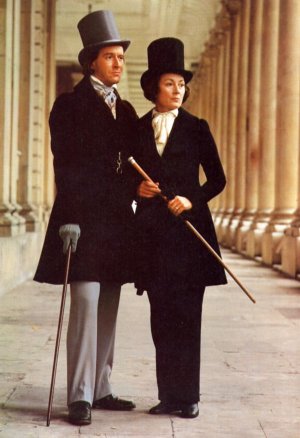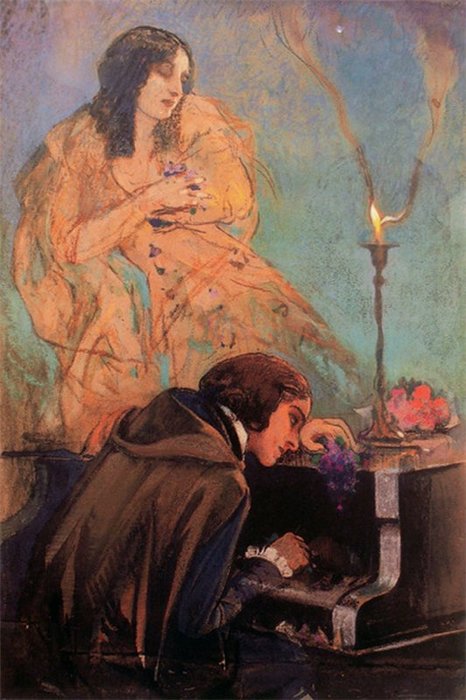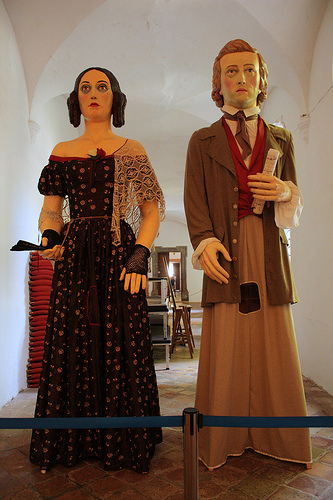Chopin’s Polishness went deeper than the color of his passport. From a musical standpoint, in fact, it was of paramount importance because of the way Polish folk music shaped his whole thinking on questions of rhythm and melody. His formal training we know, was based on the standard German repertoire of his day- including, notably, Bach’s “Well Tempered Clavier” That may seem far removed from the Chopin we know, but playing Bach was a habit that remained with him for the rest of his life.

"The figure of George Sand looms large over Chopin's later life. She is as controversial a figure to Chopin lovers today as she was in his lifetime. Was she his vampire or his guardian angel? There is so much conjecture about who did what to whom in the dramatic story of their break-up that blame is almost impossible to apportion. Solange, Sand's daughter, undoubtedly stirred up a hornets' nest with her poisonous tongue. Winter in MajorcaBut she was a product of an overprotective mother who she felt never loved her. "She spoiled me without loving me. I didn't need a horse or fancy clothes, I needed affection," she claimed after Chopin's death. Indeed Chopin was one of the few people who always stood by George Sand's daughter, and be paid a terrible price for his loyalty." Read More: http://www.michael-lunts.co.uk/georgesand.htm image: http://www.alanhoward.org.uk/notorious.htm
But if Bach was a cornerstone of the Chopin edifice, as the subtle counterpoint of many of his pieces confirms it, then another was the Polish peasant music he heard on all sides as he was growing up. It gave him a taste for an entirely different kind of melody than the foursquare German triad-tunes that dominate the symphonies and sonatas of the German romantics. Although the very term “folk music” had not yet been invented- the eastern European aristocracy still referred to it as “coachmen’s music, because they always heard their coachmen singing it- we know that Chopin was thoroughly familiar with it.
Since Chopin used to listen to this “folk music” and play it when he went to the country for the holidays, most of his first compositions were mazurkas and polonaises. The rhythm of the mazurka, for Chopin, performed precisely the same service as the Hungarian “verbunkos” did for Bartok . It liberated Chopin from the foursquare “classical” rhythms of the conventional tradition- the one-two-three-four- of the military march, and the slide-two-three of waltz time. Mazurkas are song-based country dances from the plains of Mazovia, where Warsaw is located; their usual time signature is three-four or three-eight, but Chopin’s mazurkas are so irregular in their rhythm Meyerbeer thought it was two-four and Charles Halle proved to Chopin he had played one in four-four, to which Chopin, laughing, explained this was the national way of doing things.Proper” Chopin style is at once a seal of approval and the subject of endless debate. It involves lightness and clarity of touch,

Ivan Grigor’evich Miasoedov (1881-1953) Fryderyk Chopin and George Sand Read More: http://themagiclantern.tumblr.com/post/847428274/ivan-grigorevich-miasoedov-1881-1953-fryderyk
Chopin was often taken to task for his recklessly unrhythmical playing and for a non-observance of the established norms. But, this is precisely what Chopin’s music sets out to do. Instead of coming down with a thump on the obvious downbeat of a phrase, his accents come at unexpected places, so that it seems as though he has allowed his rhythms to get out of hand, just as he has let the harmonies slip through his fingers without bothering to get a firm grip on the tonic.
Most important, and most elusive, Chopin style involves rubato — changing tempo or rhythm for expressive purposes. The question of rubato dogs Chopin performance. The composer was said to be quite free as a pianist, but it’s not clear what this meant: There are indications that he kept a fairly steady left-hand beat at all times.

"Sand's biographers often see Chopin as a millstone around the neck of an extraordinary and diversely-talented woman. The Last BalladeChopin's biographers are more likely to depict Sand as responsible, in some way at least, for the early death of the composer by relinquishing her care for him in his last years. This is also, of course, a tacit admission that we have her to thank for keeping him alive for so long and well enough to compose. As she had discovered early on in their relationship, on a trip to Majorca in 1838, Chopin was peculiarly vulnerable to illness, his constitution undermined by tuberculosis." image: http://radaris.com/p/George/Islas/
Still, generations of performers, following the misguided notion that a piece of music is a canvas upon which they are to express themselves, take Chopin’s advocacy of rubato as license to slow down and speed up almost at will. Hearing a lot of Chopin — even in some cases very good Chopin — can leave me seasick from listening to too many phrases being stretched out as if going slowly uphill, then tumbling helter-skelter down again. Read More: http://www.washingtonpost.com/wp-dyn/content/article/2010/02/18/AR2010021806498.html
These idiosyncracies did not prevent him from being, at nineteen, the foremost pianist in Warsaw, a local prodigy obviously destined for a larger, better, illuminated stage. In 1829, he left Poland and after eight inhospitable months in Vienna- where under more favorable conditions may have become a successor to Schubert- he made his way to Paris. In Stuttgart, en route, he learned that the Polish rebellion had been crushed by the Russians, and tradition has it that the Revolutionary Etude was prompted by the appalling news.

"A Song to Remember" Read Mor
ttp://www.acertaincinema.com/browse/person/cornel-wilde/?p1=$&p2=1&p3=1&p4=1But he Paris of 1831 promptly restored his spirits. It was the ideal home for him; a city of brilliant men bringing romanticism to full potential: Balzac, Victor Hugo, Theophile Gautier, Alfred de Vigny and others. Stendhal, of the older generation, had just published “The Red and the Black” . The Baroness Aurore Dudevant- better known to her readers as George Sand- was working on her first successful novel, “Indiana” . Ingres and Delacroix, the Chopin and Liszt of French painting, were producing some of their best pictures.
Chopin’s music has sometimes been branded effeminate, or “salon music”: not quite serious, not quite healthy, not quite German, since it departs from the structural conventions of the great Viennese classical school. Even the two powerful sonatas are unconventional, playing fast and loose with the structural conventions upheld by Mozart and Beethoven….
…The view of the work as fragile and sickly is also linked to the pervasive idea of Chopin as a prototypical Romantic genius: pale and dapper, doomed to a tragically short life (he had tuberculosis), needing the care of a strong mother figure (his lover, best known by her literary pseudonym, George Sand), receiving the divine flash of inspiration at the keyboard (though a brilliant improviser, he labored over his compositions).Read More: http://www.washingtonpost.com/wp-dyn/content/article/2010/02/18/AR2010021806498.html
…The work isn’t fragile, though. Although Chopin himself was said to shrink away from too-loud playing, there’s plenty in it that thunders and plenty that’s assertive. It’s also strikingly original. Chopin, unlike many composers of his day, wasn’t under the sway of Beethoven. He abhorred, for instance, the start of the last movement of the Fifth Symphony; his primary influences were earlier, particularly Johann Sebastian Bach. Read More: http://www.washingtonpost.com/wp-dyn/content/article/2010/02/18/AR2010021806498_2.html





 COMMENTS
COMMENTS